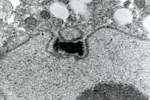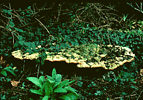|
ID
|
Thumbnail |
Media Data |
| 31 |

|
|
Comments
|
Portion of a hypha of a zygomycete stained with a blue dye to show the many nuclei present. Many other fungi have septations that devide the hyphae into compartments that usually contain one to several nuclei per compartment.
|
|
Copyright
|
© 1996 Meredith Blackwell

|
|
Image Use
|
ToL use only
|
|
Attached to Group
|
Zygomycota: view page image collection
|
|
Title
|
5.gif
|
|
Image Type
|
Photograph
|
|
Image Content
|
Body Parts, Ultrastructure
|
|
ID
|
31
|
|
| 525 |

|
|
Scientific Name
|
Pilobolus crystallinus (Mucoromycotina)
|
|
Comments
|
Black sporangium atop swollen sporangiophore. Shortly, the swollen subsporangial vesicle will burst to send the sporangium flying. Herbivores eat the sporangium, and the enclosed mitospores germinate in the dung. The bright yellow carotenoid pigment enables the sporangium to orient to light (phototropism). If you look closely, you can see masses of nematodes on the vesicle; probably herbivore pathogens hoping to hitch a ride.
|
|
Specimen Condition
|
Live Specimen
|
|
Copyright
|
© 1996 Meredith Blackwell

|
|
Image Use
|
ToL use only
|
|
Attached to Group
|
Mucoromycotina (Zygomycota): view page image collection
|
|
Title
|
p.2.gif
|
|
Image Type
|
Photograph
|
|
Image Content
|
Specimen(s)
|
|
ALT Text
|
Black sporangium atop swollen Pilobolus sporangiophore
|
|
ID
|
525
|
|
| 743 |

|
|
Comments
|
Hyphae of a wood-decaying fungus found growing on the underside of a fallen log. The metabolically active hyphae have secreted droplets on their surfaces.
|
|
Specimen Condition
|
Live Specimen
|
|
Copyright
|
© 1996 Meredith Blackwell

|
|
Image Use
|
ToL use only
|
|
Attached to Group
|
Fungi: view page image collection
|
|
Title
|
2.gif
|
|
Image Type
|
Photograph
|
|
Image Content
|
Specimen(s)
|
|
ID
|
743
|
|
| 1651 |

|
|
Comments
|
Transmission electron micrograph showing duplicated spindle pole body of a prophase I meiotic nucleus of a basidiomycete Exobasidium. Only chytrids among fungi have centrioles and lack spindle pole bodies.
|
|
Specimen Condition
|
Dead Specimen
|
|
Copyright
|
© 1996 Beth Richardson
|
|
Image Use
|
restricted
|
|
Attached to Group
|
Basidiomycota: view page image collection
|
|
Title
|
6.gif
|
|
Image Type
|
Photograph
|
|
Image Content
|
Ultrastructure
|
|
ID
|
1651
|
|
| 1842 |

|
|
Scientific Name
|
Chytridium (Chytridiomycota)
|
|
Comments
|
Individual growing on a single pine pollen grain. Successive photos show zoospore release from the sporangium, and the arrow points to a flagellum.
|
|
Copyright
|
© 1996 H. Whisler, M. Fuller
|
|
Image Use
|
restricted
|
|
Title
|
c.gif
|
|
Image Type
|
Photograph
|
|
Image Content
|
Specimen(s)
|
|
ALT Text
|
Chytridium growing on a single pine pollen grain. Successive photos show zoospore release from the sporangium, and the arrow points to a flagellum.
|
|
ID
|
1842
|
|
| 2410 |

|
|
Scientific Name
|
Rhizopogon rubescens
|
|
Comments
|
The fluffy white hyphae of the mycorrhizal fungus Rhizopogon rubescens has enveloped the smaller roots of a Virginia pine seedling. Note that some of the mycelium extends out into the surrounding environment.
|
|
Specimen Condition
|
Live Specimen
|
|
Copyright
|
© 1996 J. B. Anderson
|
|
Image Use
|
restricted
|
|
Attached to Group
|
Boletales: view page image collection
|
|
Title
|
3.gif
|
|
Image Type
|
Photograph
|
|
Image Content
|
Specimen(s)
|
|
ID
|
2410
|
|
| 3950 |

|
|
Comments
|
Entomophthora, "destroyer of insects", is the agent of a fungual infection that kills flies. After their death the fungal growth erupts through the fly cuticle, and dispersal by forcible spore discharge is a source of inoculum for infection of new flies.
|
|
Specimen Condition
|
Live Specimen
|
|
Copyright
|
© 1996 George Barron

|
|
Image Use
|
restricted
|
|
Attached to Group
|
Entomophthorales : view page image collection
|
|
Title
|
4.gif
|
|
Image Type
|
Photograph
|
|
Image Content
|
Specimen(s)
|
|
ID
|
3950
|
|
| 4863 |

|
|
Scientific Name
|
Rigidioporus ulmarius
|
|
Location
|
Royal Botanic Gardens, Kew, UK
|
|
Comments
|
Largest basidiocarp world record holder. The basidiocarp is shown in its largest dimension (170 cm or over 5 1/2 feet).
|
|
Specimen Condition
|
Live Specimen
|
|
Copyright
|
© 1996 D. Pegler
|
|
Image Use
|
restricted
|
|
Attached to Group
|
Polyporales: view page image collection
|
|
Title
|
8.gif
|
|
Image Type
|
Photograph
|
|
Image Content
|
Specimen(s)
|
|
ID
|
4863
|
|
| 5224 |

|
|
Scientific Name
|
Laetiporus sulphureus (Basidiomycota, Agaricomycetes, Polyporales)
|
|
Comments
|
Massed fruiting bodies of the chicken-of-the-woods. The tiny tubular filaments (hyphae) that make the body of this fungus (mycelium) are growing in the old, dead wood of a large cherry tree. Laetiporus is not a parasite, but the decay may weaken the tree so much that wind or ice storms can topple it.
|
|
Specimen Condition
|
Live Specimen
|
|
Copyright
|
© 1996 Meredith Blackwell

|
|
Image Use
|
ToL use only
|
|
Attached to Group
|
Polyporales: view page image collection
|
|
Title
|
l.gif
|
|
Image Type
|
Photograph
|
|
Image Content
|
Specimen(s)
|
|
ALT Text
|
Massed fruiting bodies of the chicken-of-the-woods
|
|
ID
|
5224
|
|
| 5380 |

|
|
Scientific Name
|
Sarcoscypha coccinea (Ascomycota, Pezizomycotina, Pezizales)
|
|
Comments
|
Fruiting body of the scarlet cup fungus. Hundreds of millions of meiospores (ascospores) are discharged from this cup, usually in puffs that produce visible clouds of spores.
|
|
Specimen Condition
|
Live Specimen
|
|
Copyright
|
© 1996 Joey Spatafora

|
|
Image Use
|
ToL use only
|
|
Attached to Group
|
Pezizales: view page image collection
|
|
Title
|
s.2.gif
|
|
Image Type
|
Photograph
|
|
Image Content
|
Specimen(s)
|
|
ALT Text
|
Fruiting body of the scarlet cup fungus
|
|
ID
|
5380
|
|











 Go to quick links
Go to quick search
Go to navigation for this section of the ToL site
Go to detailed links for the ToL site
Go to quick links
Go to quick search
Go to navigation for this section of the ToL site
Go to detailed links for the ToL site